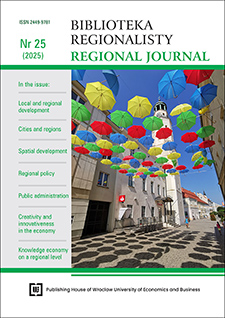AI in Architectural Education – Analysis of Awareness; Popularity; and Application of Artificial Intelligence Tools among Students
DOI:
https://doi.org/10.15611/br.2025.1.01Keywords:
architectural design, AI tools, artificial intelligence, architectural education, AI in architectureAbstract
Aim: This article aims to analyze the awareness, popularity, and scope of artificial intelligence (AI) tools among students of architecture and spatial management. The study seeks to determine the role of AI in education and identify factors influencing its adoption in the academic environment.
Methodology: The research was conducted as a pilot online survey targeting students of the Faculty of Architecture at Wrocław University of Science and Technology. A quantitative approach enriched with qualitative elements was used, allowing for the analysis of both numerical data and individual respondent opinions.
Results: The results indicate that, despite a relatively low self-assessment of AI proficiency, these tools are widely recognized by students. Most respondents acquire knowledge about AI through informal sources, such as social media and self-study, while its use in academic education and the design process remains limited. Key barriers include a lack of knowledge, complex operation, and restricted access to specialized software.
Implications and recommendations: The findings highlight the need to integrate AI into the curriculum and introduce dedicated courses to develop students’ digital competencies. Additionally, adapting AI tools to educational needs and promoting an interdisciplinary approach to AI learning is recommended.
Originality/value: This article focuses on AI integration in architectural education from the perspective of students in architecture and spatial management. Unlike previous studies that primarily addressed technological and practical applications of AI in design, this research identifies key barriers limiting its broader adoption in academia. It also considers user comfort and concerns regarding AI’s impact on creativity and future professional competencies. The pilot study allows for a preliminary examination of these issues and suggests directions for further research on the effective integration of AI into architectural education.Downloads
References
Adamiczka, B. (2022). Proces twórczego rozwiązywania problemów jako strategia projektowania formy architektonicznej w kontekście zjawiska percepcji. Rozprawa doktorska. Politechnika Wrocławska, Wydział Architektury.
Almaz, A., El-Agouz, E., Abdelfatah, M. i Raafat, I. (2024). The Future Role of Artificial Intelligence (AI) Design's Integration into Architectural and Interior Design Education is to Improve Efficiency, Sustainability, and Creativity. Civil Engineering and Architecture, 12(3), 1749-1772. https://doi.org/10.13189/cea.2024.120336
Brandl, R. i Ellis C., (2024, 29 maja). ChatGPT Statistics and User Numbers 2024 – OpenAI Chatbot. Tooltester (blog). Pobrano 15 listopada 2024 z https://www.tooltester.com/en/blog/chatgpt-statistics/
Blinova, M. i Molodcha, M. (2024). Use of Artificial Intelligence in Educational Design for Architecture Students. Municipal Economy of Cities, 3(184), 53-58. https://doi.org/10.33042/2522-1809-2024-3-184-53-58
Chaillou, S. (2021). AI and Architecture: An Experimental Perspective. W: A. Imdat i B. Prithwish, The Routledge Companion to Artificial Intelligence in Architecture (s. 420-441). Routledge.
Cinar, S. i Demiroz, M. (2024). Integrating Text-to-Image AI in Architectural Design Education: Analytical Perspectives from a Studio Experience. Journal of Design Studio, 6(2), 247-258. https://doi.org/10.46474/jds.1526771
Hegazy, M. i Saleh, A. (2023). Evolution of AI Role in Architectural Design: Between Parametric Exploration and Machine Hallucination. MSA Engineering Journal, 2(2), 1-26. https://doi.org/10.21608/MSAENG.2023.291873
Jin, S., Tu, H., Li, J., Fang, Y., Qu, Z., Xu, F., Liu, K. i Lin, Y. (2024). Enhancing Architectural Education through Artificial Intelligence: A Case Study of an AI-Assisted Architectural Programming and Design Course. Buildings, 14(6), 1613. https://doi.org/10.3390/buildings14061613
Kwiatkowska, A. (2007). Mind-Games: Innovative Architectural Design in the Digital Age. W: Proceedings of 2007 ICAE. Central Academy of Fine Arts.
Kwiatkowska, A. (2018). Architectural Formation: The Imperfect Structural Stability and Perfect Instability of the Creation's Language. W: T. Kozłowski (red.), Defining the Architectural Space: Rationalistic or Intuitive Way to Architecture (t. 2, s. 95-108). Cracow University of Technology.
Mansour, N. (2024). Redefining Architectural Pedagogy: Navigating the Integration of Midjourney AI in Design Education. W: G. Barnes i B. Satterfield (red.), 112th ACSA Annual Meeting Proceedings, Disruptors on the Edge. https://doi.org/10.35483/ACSA.AM.112.24
Mrosla, L. i Both, P. (2019). Quo vadis AI in Architecture? Survey of the Current Possibilities of AI in the Architectural Practice. Blucher Design Proceedings, 2, 45-54. https://doi.org/10.5151/proceedings-ecaadesigradi2019_302
Newman, M. (2010). New Media, Young Audiences and Discourses of Attention: From Sesame Street to ‘Snack Culture’. Media, Culture & Society, 32(4), 581-596. https://doi.org/10.1177/0163443710367693
Nigam, A., Pasricha, R., Singh, T. i Churi, P. (2021). A Systematic Review on AI‑based Proctoring Systems Past, Present and Future. Education and Information Technologies, 26(7), 6421-6445. https://doi.org/10.1007/s10639-021-10597-x
Ortega‑Bolaños, R., Bernal-Salcedo, J., Ortiz, M., Sarmiento, J., Ruz, G. i Tabares Soto, R. (2024). Applying the Ethics of AI: A Systematic Review of Tools for Developing and Assessing AI‑based Systems. Artificial Intelligence Review, 57(5), 110. https://doi.org/10.1007/s10462-024-10740-3
Said, A., Badar, D., Hamzah, N., Syah, M. i Fariz, M. (2023). Implementation of Artificial Intelligence in the World of Architecture and Its Influence on the Profession of Architecture. Prosiding Seminar Nasional Dies Natalis UNM Ke-63, 1, 620-626. https://doi.org/10.59562/semnasdies.v1i1.1117
Singh, S. ChatGPT Statistics. (2024, 3 listopada). Number of Users & Queries. DemandSage (blog). Pobrano 15 listopada 2024 z https://www.demandsage.com/chatgpt-statistics/
Tarczewski, R. (2019). Konstruowanie architektury. Uwagi o materializacji formy architektonicznej. Oficyna Wydawnicza Politechniki Wrocławskiej.
Tellios, A., Koulali, P. i Valsamidou, K. (2023). Designing Tomorrow: AI and the Future of Architectural Design Process. Forum A+P. Venturing into the Age of AI: Insights and Perspectives, 27, 21-25. https://doi.org/10.37199/f40002703
Downloads
Published
Issue
Section
License
Copyright (c) 2025 Bartosz Adamiczka

This work is licensed under a Creative Commons Attribution-ShareAlike 4.0 International License.
Accepted 2025-04-16
Published 2025-06-27







